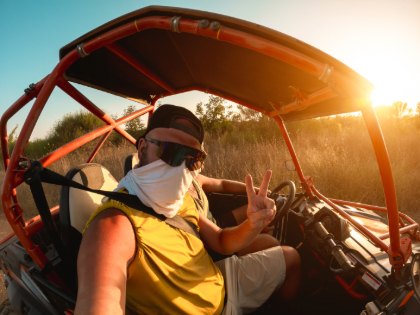INDEPENDENT DEALER
Mission, TX | (956) 458-9399
Oils RGV
OUR BLOG
08/07/2025
Are you new to side-by-side rigs? Oil Options in Knightdale, NC, provides a beginner's guide to UTVs filled with riding and safety tips. Dive in and start your off-road journey right!

Let’s be real: UTVs are a blast, but they can also be dangerous if you don’t know what you’re doing. One wrong move, a missed turn, a loose helmet strap, or ignoring a trail warning can turn an epic ride into an emergency.
These vehicles demand focus, preparation, and consistent caution, particularly for beginners. With that in mind, this beginner's guide to UTVs will help you develop the skills and awareness necessary for safe, confident riding. We’ll cover everything from essential gear to smart trail practices and more. Let’s roll!
Maximize your vehicle’s performance with top-quality AMSOIL products from Oils RGV in Mission, TX! From transmission fluid to gear lube, we’ve got you covered. Call (956) 458-9399 for friendly guidance, or shop anytime at AMSOIL’s online store!
1. Protective Gear: Your First Line of Defense
A DOT-certified helmet is essential, regardless of riding conditions. Head injuries can occur even during low-speed tip-overs, making proper head protection non-negotiable.
Complement your helmet with durable gloves, eye protection, and sturdy over-the-ankle boots. Long sleeves and pants provide additional abrasion resistance. For added safety, consider padded jackets or armor, particularly when riding challenging terrain.
Always use the vehicle’s seat belts or harness system. Ejection remains a leading cause of UTV-related injuries, and restraints significantly reduce this risk.
Carry emergency supplies, including a first-aid kit, fire extinguisher, basic tools, and sufficient water. Remote rides warrant additional precautions, such as a GPS device or satellite communicator.
2. Trail Etiquette and Legal Compliance
Research local regulations before riding. Many jurisdictions require registration, permits, or restrict UTV access to designated trails. Age and licensing requirements also vary.
Stay on marked trails. Off-trail riding damages ecosystems and often violates land-use policies, potentially resulting in fines or trail closures.
Yield appropriately. Uphill traffic typically has the right of way, as stopping and restarting on inclines is more difficult. Reduce speed when encountering hikers, cyclists, or horseback riders.
Minimize excessive noise and dust, particularly near campsites or residential areas. Responsible riding helps maintain positive relationships between UTV enthusiasts and other trail users.
3. Pre-Ride Inspection and Maintenance
Conduct a thorough inspection before each ride. Check tire pressure and condition, fluid levels, and brake functionality. Ensure all lights and indicators operate correctly.
Test throttle response and braking performance. The throttle should engage smoothly without hesitation, and brakes must provide consistent stopping power.
Secure all cargo and confirm passenger capacity is not exceeded. Unrestrained items become hazardous in the event of sudden stops or rollovers.
Keep your UTV running at peak performance with AMSOIL 10W-40 100% Synthetic ATV/UTV Motor Oil. Call Oils RGV in Mission, TX, at (956) 458-9399 to pick some up, or shop AMSOIL’s full lineup of synthetic oils online today!
4. Safe Operating Techniques
Begin with controlled environments. Practice basic maneuvers on flat, open terrain before attempting technical trails. Familiarize yourself with the UTV’s handling characteristics, including turning radius and braking distance.
Avoid reckless behavior. Jumping, sharp donuts, or other stunts significantly increase rollover risk. Never operate a UTV under the influence of alcohol or drugs.
Adapt speed to terrain conditions. Loose surfaces like gravel, sand, or mud require reduced speeds and increased following distances. Exercise additional caution in wet or icy conditions.
Ensure passengers remain seated with restraints fastened at all times. No limbs should extend outside the vehicle during operation.
5. Maintaining Situational Awareness
Continuously scan the trail for obstacles like rocks, ruts, or low-hanging branches. Unfamiliar terrain warrants extra vigilance.
Monitor weather conditions. Sudden rain can create slippery surfaces and reduce visibility. Prepare for temperature fluctuations with appropriate clothing.
Recognize when to turn back. If conditions deteriorate or a trail exceeds your skill level, retreating is the prudent choice.
Inform someone of your route and expected return time. When riding in groups, maintain communication via two-way radios or GPS-enabled devices.
Conclusion
UTV riding offers both utility and recreation, but safety must remain the priority. Proper gear, adherence to regulations, routine maintenance, disciplined operation, and constant awareness form the pillars of responsible riding.
By integrating these practices, beginners can develop skills that ensure longevity in the sport. For further education, consider certified training courses to refine techniques and deepen safety knowledge.
Ride prepared, ride alert, and, most importantly, ride safely.
Our beginner's guide to UTVs is the first step toward smart riding. Next up? Quality maintenance with AMSOIL! Contact Oils RGV in Mission, TX, at (956) 458-9399 for AMSOIL products tailored to your UTV. Want it fast and easy? Head to AMSOIL’s online store and restock in minutes!
CONTACT